Abstract
The prevalence of bacterial pathogens and rotavirus in 2,908 patients with diarrhea who were admitted to San Lazaro Hospital in Manila in 1983 and 1984 was determined. One or more enteric pathogens were isolated or detected in samples from 1,698 (58.4%) patients. Isolation rates for the various enteropathogens were as follows: rotavirus, 30.6%; Shigella spp., 11.6%; Salmonella spp., 9.2%; enterotoxigenic Escherichia coli (1983 only), 7.8%; Vibrio cholerae biotype eltor, 3.8%; non-O1 V. cholerae, 2.8%; Vibrio parahaemolyticus, 1.7%; other Vibrio spp., 1.1%; Campylobacter jejuni, 3.0%; Aeromonas hydrophila, 1.3%; and Plesiomonas shigelloides 1.1%. Giardia lamblia and Entamoeba histolytica were detected in 0.6 and 0.1%, respectively, of stool samples examined. Determination of the etiologic role of isolates was complicated by one or more of the following factors: isolation of multiple enteric pathogens (302 cases); isolation of Salmonella spp., enterotoxigenic E. coli, and C. jejuni from a similar proportion of asymptomatic control patients and patients with diarrhea; and isolation of a high proportion of certain pathogens (especially Salmonella spp.) only from enrichment broth, suggesting infection with a small number of organisms. Isolation of V. cholerae eltor was seasonal, with the majority of cases occurring in the rainy months. In addition, the number of patients with diarrhea increased with the onset of the monsoon rains and peaked during the months of maximum rainfall. Rotavirus infection occurred in both children and adults throughout the year and was the most frequently identified cause of diarrhea in children under 5 years of age. Shigella spp. were the most common agents of diarrhea in adults.
Full text
PDF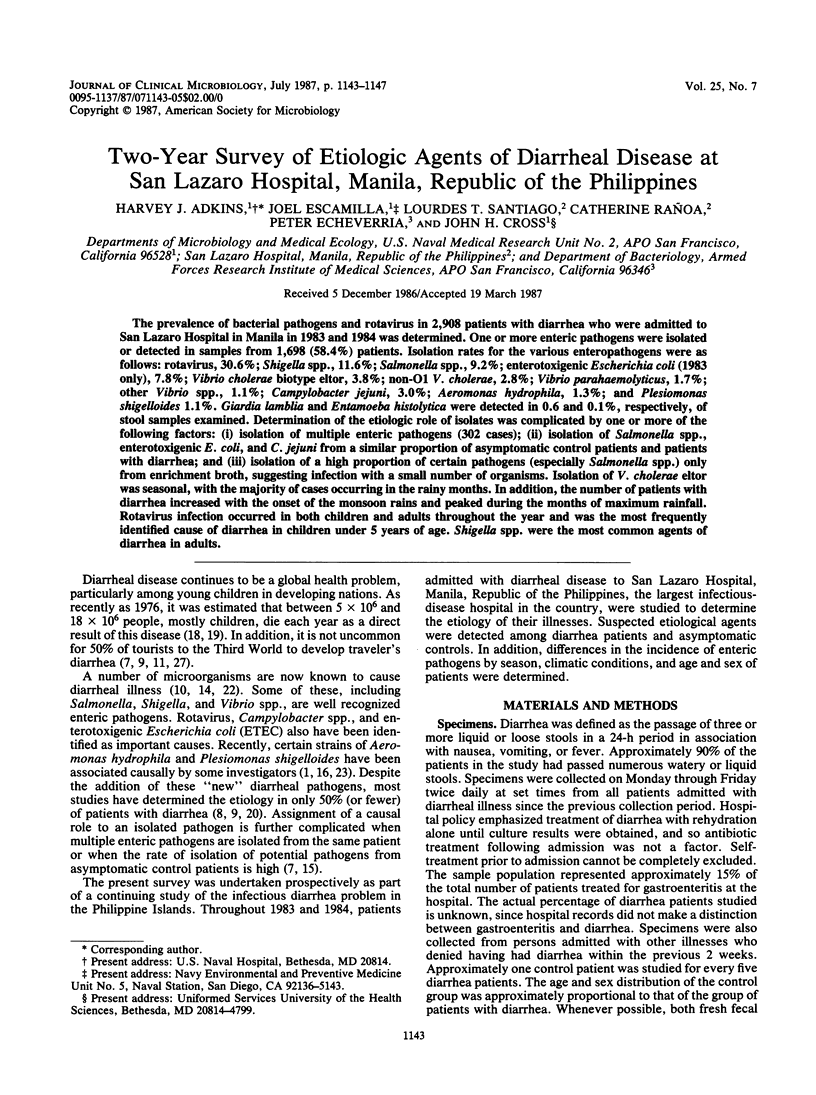
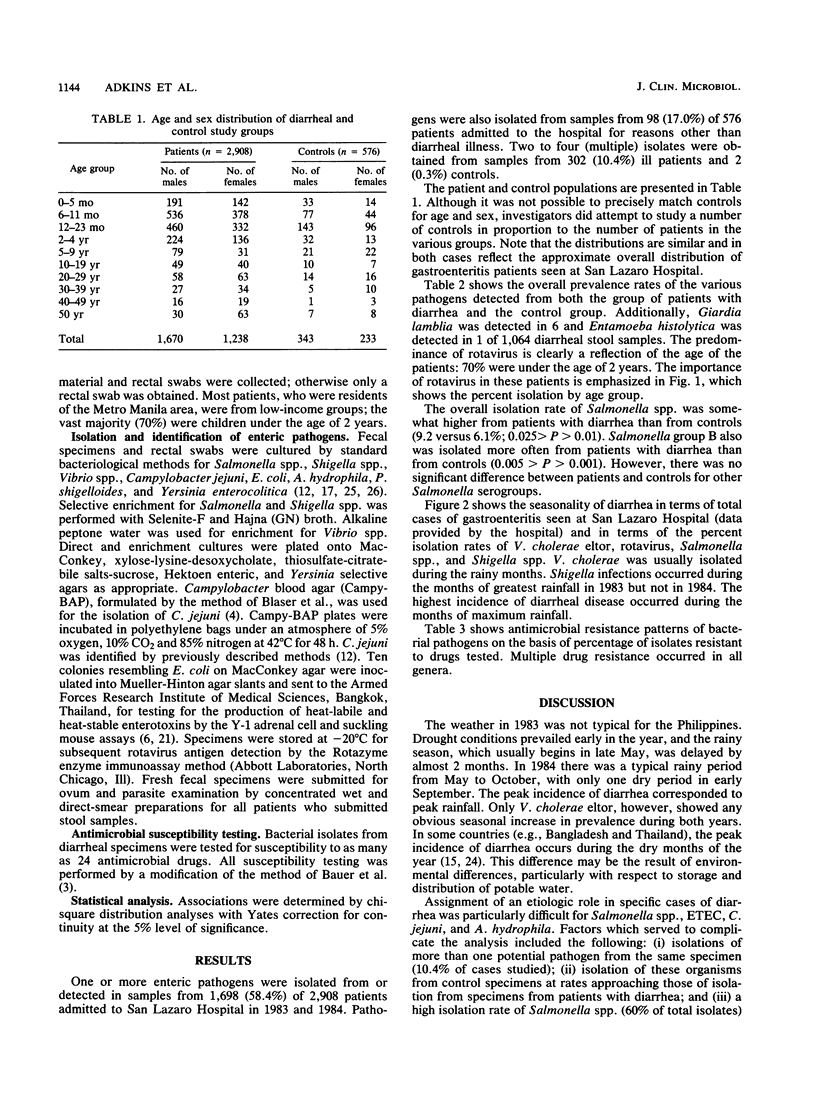
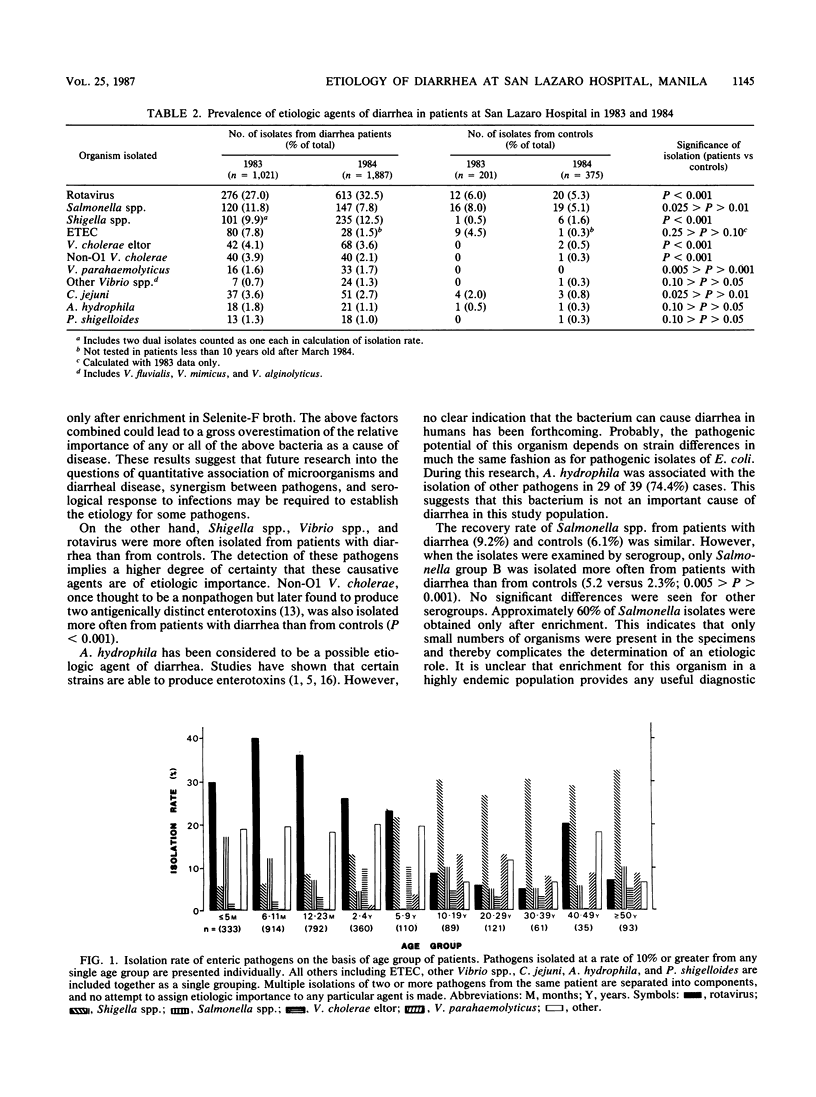
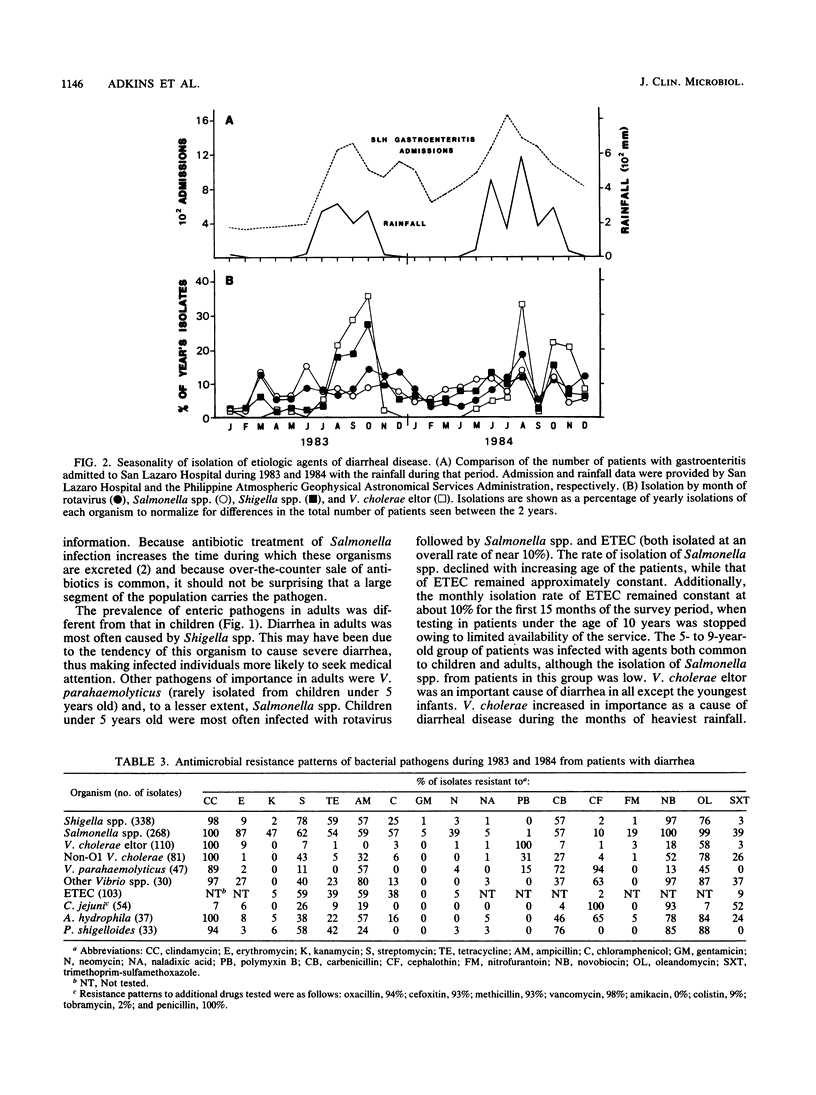
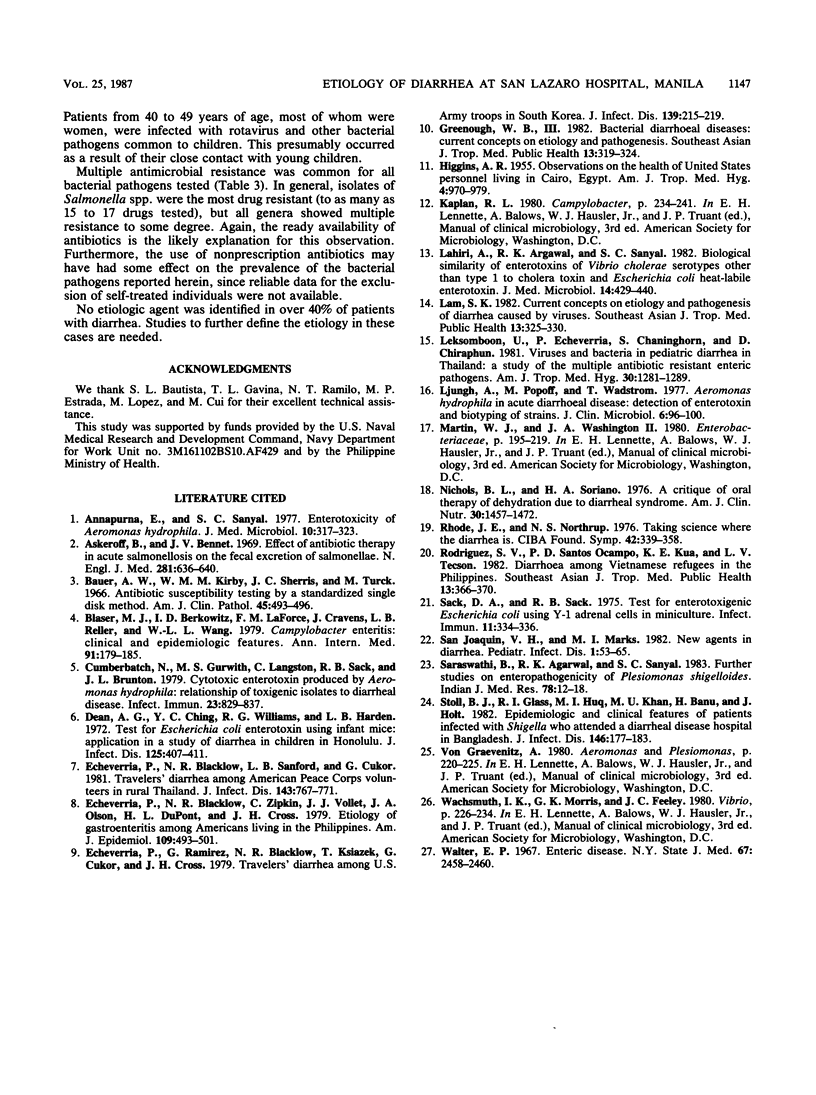
Selected References
These references are in PubMed. This may not be the complete list of references from this article.
- Annapurna E., Sanyal S. C. Enterotoxicity of Aeromonas hydrophila. J Med Microbiol. 1977 Aug;10(3):317–323. doi: 10.1099/00222615-10-3-317. [DOI] [PubMed] [Google Scholar]
- Aserkoff B., Bennett J. V. Effect of antibiotic therapy in acute salmonellosis on the fecal excretion of salmonellae. N Engl J Med. 1969 Sep 18;281(12):636–640. doi: 10.1056/NEJM196909182811202. [DOI] [PubMed] [Google Scholar]
- Bauer A. W., Kirby W. M., Sherris J. C., Turck M. Antibiotic susceptibility testing by a standardized single disk method. Am J Clin Pathol. 1966 Apr;45(4):493–496. [PubMed] [Google Scholar]
- Blaser M. J., Berkowitz I. D., LaForce F. M., Cravens J., Reller L. B., Wang W. L. Campylobacter enteritis: clinical and epidemiologic features. Ann Intern Med. 1979 Aug;91(2):179–185. doi: 10.7326/0003-4819-91-2-179. [DOI] [PubMed] [Google Scholar]
- Cumberbatch N., Gurwith M. J., Langston C., Sack R. B., Brunton J. L. Cytotoxic enterotoxin produced by Aeromonas hydrophila: relationship of toxigenic isolates to diarrheal disease. Infect Immun. 1979 Mar;23(3):829–837. doi: 10.1128/iai.23.3.829-837.1979. [DOI] [PMC free article] [PubMed] [Google Scholar]
- Dean A. G., Ching Y. C., Williams R. G., Harden L. B. Test for Escherichia coli enterotoxin using infant mice: application in a study of diarrhea in children in Honolulu. J Infect Dis. 1972 Apr;125(4):407–411. doi: 10.1093/infdis/125.4.407. [DOI] [PubMed] [Google Scholar]
- Echeverria P., Blacklow N. R., Sanford L. B., Cukor G. G. Travelers' diarrhea among American Peace Corps volunteers in rural Thailand. J Infect Dis. 1981 Jun;143(6):767–771. doi: 10.1093/infdis/143.6.767. [DOI] [PubMed] [Google Scholar]
- Echeverria P., Blacklow N. R., Zipkin C., Vollet J. J., Olson J. A., DuPont H. L., Cross J. H. Etiology of gastroenteritis among Americans living in the Philippines. Am J Epidemiol. 1979 Apr;109(4):493–501. doi: 10.1093/oxfordjournals.aje.a112706. [DOI] [PubMed] [Google Scholar]
- Echeverria P., Ramirez G., Blacklow N. R., Ksiazek T., Cukor G., Cross J. H. Travelers' diarrhea among U.S. Army troops in South Korea. J Infect Dis. 1979 Feb;139(2):215–219. doi: 10.1093/infdis/139.2.215. [DOI] [PubMed] [Google Scholar]
- Greenough W. B., 3rd Bacterial diarrhoeal diseases: current concepts on etiology and pathogenesis. Southeast Asian J Trop Med Public Health. 1982 Sep;13(3):319–324. [PubMed] [Google Scholar]
- HIGGINS A. R. Observations on the health of United States personnel living in Cairo, Egypt. Am J Trop Med Hyg. 1955 Nov;4(6):970–979. doi: 10.4269/ajtmh.1955.4.970. [DOI] [PubMed] [Google Scholar]
- Lahiri A., Agarwal R. K., Sanyal S. C. Biological similarity of enterotoxins of Vibrio cholerae serotypes other than type 1 to cholera toxin and Escherichia coli heat-labile enterotoxin. J Med Microbiol. 1982 Nov;15(4):429–440. doi: 10.1099/00222615-15-4-429. [DOI] [PubMed] [Google Scholar]
- Lam S. K. Current concepts on etiology and pathogenesis of diarrhoea caused by viruses. Southeast Asian J Trop Med Public Health. 1982 Sep;13(3):325–330. [PubMed] [Google Scholar]
- Leksomboon U., Echeverria P., Suvongse C., Duangmani C. Viruses and bacteria in pediatric diarrhea in Thailand: a study of multiple antibiotic-resistant enteric pathogens. Am J Trop Med Hyg. 1981 Nov;30(6):1281–1290. doi: 10.4269/ajtmh.1981.30.1281. [DOI] [PubMed] [Google Scholar]
- Ljungh A., Popoff M., Wadstrom T. Aeromonas hydrophila in acute diarrheal disease: detection of enterotoxin and biotyping of strains. J Clin Microbiol. 1977 Aug;6(2):96–100. doi: 10.1128/jcm.6.2.96-100.1977. [DOI] [PMC free article] [PubMed] [Google Scholar]
- Nichols B. L., Soriano H. A. A critique of oral therapy of dehydration due to diarrheal syndromes. Am J Clin Nutr. 1977 Sep;30(9):1457–1472. doi: 10.1093/ajcn/30.9.1457. [DOI] [PubMed] [Google Scholar]
- Rodriguez S. V., Santos Ocampo P. D., Ka E. K., Tecson L. V. Diarrhoea among Vietnamese refugees in the Philippines. Southeast Asian J Trop Med Public Health. 1982 Sep;13(3):366–372. [PubMed] [Google Scholar]
- Rohde J. E., Northrup R. S. Taking science where the diarrhoea is. Ciba Found Symp. 1976;(42):339–366. doi: 10.1002/9780470720240.ch18. [DOI] [PubMed] [Google Scholar]
- Sack D. A., Sack R. B. Test for enterotoxigenic Escherichia coli using Y-1 adrenal cells in miniculture. Infect Immun. 1975 Feb;11(2):334–336. doi: 10.1128/iai.11.2.334-336.1975. [DOI] [PMC free article] [PubMed] [Google Scholar]
- San Joaquin V. H., Marks M. I. New agents in diarrhea. Pediatr Infect Dis. 1982 Jan-Feb;1(1):53–65. doi: 10.1097/00006454-198201000-00016. [DOI] [PubMed] [Google Scholar]
- Saraswathi B., Agarwal R. K., Sanyal S. C. Further studies on enteropathogenicity of Plesiomonas shigelloides. Indian J Med Res. 1983 Jul;78:12–18. [PubMed] [Google Scholar]
- Stoll B. J., Glass R. I., Huq M. I., Khan M. U., Banu H., Holt J. Epidemiologic and clinical features of patients infected with Shigella who attended a diarrheal disease hospital in Bangladesh. J Infect Dis. 1982 Aug;146(2):177–183. doi: 10.1093/infdis/146.2.177. [DOI] [PubMed] [Google Scholar]
- Walter E. P. Problems in global medicine. Enteric disease. N Y State J Med. 1967 Sep 15;67(18):2458–2460. [PubMed] [Google Scholar]


